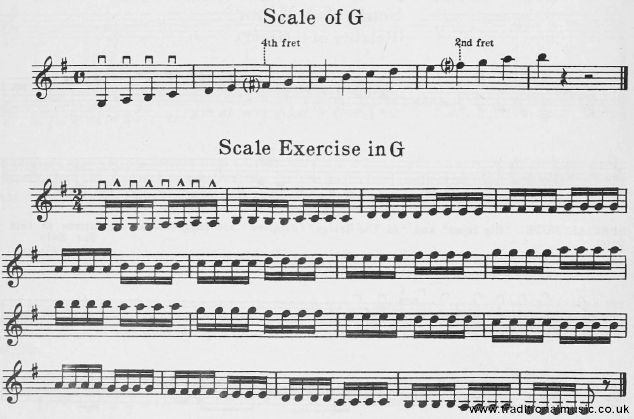Mandolin Self Instructor, online tutorial - Page 28
A simplified self learning system for the Mandolin with tuning instruction, song folio, chord diagrams, sheet music and PDF for printing. By ZARH MYRON BICKFORD
| Share page | Visit Us On FB |
|
Key Signatures
There are as many keys as there are chromatic tones in the scale-twelve, and each of these
keys is distinguished by a sign or signature, consisting of sharps or flats placed at the beginn- ing of the staff, immediately after the clef sign. The key of C (and its relative-A minor,) in which all the Studies and Exercises have been thus far, is called the natural key, since no sharps nor flats are required to represent its tones, nor, on the piano, anything but the white keys. The scale of C is taken as a model or standard for all other scales, the same order of steps and half steps being followed, no matter what tone maybe taken as the starting point or key-tone. Thus it fol- lows that when the scale is started on G-, it becomes necessary to sharp the F, in order to bring a whole step between the sixth and seventh and a half step between the seventh and eighth tones of the scale. This necessary change could be indicated by inserting the sharp before every F occurring in the composition, a method occasionally used during a temporary transition to another key, but the us- ual method is to place the sharp on the fifth line of the staff at the beginning, thus indicating that all F's .whether occurring on this particular line or on another octave (as in the first space,) are to be sharped, and that the scale or composition is in the key of GL It will thus be seen that it is very im- portant that the key signature be carefully examined before a piece is played. In the following illustration, the sharps are placed in parenthesis before the F's merely as a si- lent reminder. |
||
 |
||
|
(SPECIAL NOTE. A thorough understanding of the scales, and their constant practice at a later period of development
is very essential and for this purpose all the scales, major and minor, have been grouped together in one of the later volumes of this Method, arranged in a form that will be found not only useful technically, but interesting musically.) "/ have never been in favor of the many automatic mechanical methods of producing touch. There is really on- ly one real way of teaching and that is through the sense of hearing of the pupil." OSSfP GABRILOWITSCH |
||